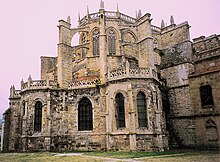
Castro Urdiales or 'Castro' for short is a town of 32,000 people (2018) in the Spanish province of Cantabria. It is a popular tourist destination that offers a sports harbour, a fishing harbour and two beaches.
Understand
[edit]Castro Urdiales is a modern town, although its castle and the Gothic-style parish church of Santa María de la Asunción, date from the Middle Ages. It was founded by the Romans as "Flaviobriga". Its chief industries are tourism, fishing, and the preservation of fish, especially sardines and anchovies, in oil. The Lolin and La Castreña anchovy canning factories serve as a reminder of the town's closeness to this industry and its proximity to the sea.
Although the number of people registered in the town is around 32,000, in summer the population can be double or even triple this figure. The town is popular because of its beaches and scenic harbour.
In the centre of the town, the city hall is surrounded by a square. Close to it, right by the ocean, are the lighthouse and the church.
Get in
[edit]Castro Urdiales is easily reached via the A8 freeway (Autovia) from Bilbao (about 35 km) and from Santander. Public transport buses go to Bilbao every 30 minutes and costs €3.21. Santander is roughly an hour by bus and buses go to Santander every 1-2 hours. The closest airports are Bilbao and Santander. The Bilbao - Castro bus service is provided by RB and timetables can be found here
- 1 Castro-Urdiales bus terminal (Terminal de Autobuses de Castro-Urdiales), Calle Leonardo Rucabado.
Get around
[edit]Castro is small enough that you can walk nearly everywhere. The furthest distance is to walk from Brazomar Beach to Ostende Beach. It is about 2-3 km and takes accordingly 30-45 min of walking.
See
[edit]- The monument complex of Castro Urdiales, known as Puebla Vieja, has medieval origins and is near the sea. It was declared a Conjunto histórico in 1978.

- The Church of Santa María de la Asunción is in Gothic style. Built under the protection of King Alfonso VIII of Castile in the 13th century (though it was finished in the 15th century), it is a basilica church with three naves. In the interior are the images of the White Virgin and the Reclining Christ, and three Gothic carvings of the Magi. It was declared a National Monument in 1931.
- Roman mile-stone, opposite the Church of Santa María. Dating to 61 AD, it marked the distance to Pisoraca. It has an inscription that reads "Nero Claudius, son of the divine Claudius, Caesar, Augustus, Germanicus, Pontifex maximus, with the tribunician power for eighth time, the empire for ninth and the consulate for fourth. From Pisoraca one hundred and eighty miles".
- The Castle of Santa Ana is near the port and the church of Santa María de la Asunción. In modern times it housed a lighthouse.
- Ocharan Palace, castle-observatory and Ocharan gardens, protected since 1985. The castle-observatory, dating back to 1914 and designed by local architect Eladio Laredo, is in neo-Gothic style. The Ocharan Palace, or Toki-Eder, was built in 1901, also by the local architect Eladio Laredo. It is an eclectic-style building, with a portico of columns and other elements of Greek taste, and with a multicolored tile frieze designed by Daniel Zuloaga.
- Remains of Flavióbriga and the medieval village, protected since 1996. The Flavióbriga archaeological site is under the Old Town, 2 m deep. Remains of a Roman colony can be visited in the Regional Museum of Prehistory and Archaeology of Cantabria.
- City Hall (16th century)
- Iglesia de San Pedro (11th century), in Romanesque style.
Nearby
[edit]- Ruins of the medieval tower of the Templars, in Allendelagua, on the mountain side. It belonged to the Knights Templars and is in poor condition.
- Cave of El Cuco, west of the town. It houses rock carvings and paintings from the Upper Paleolithic period, which depict animals such as deer, goats and horses.
- Water driving of El Chorrillo, a work of hydraulic engineering from the Roman age.
- Tower-House of Los Otañes, in Otañes.
- Ruins of the Hospital de la Vera Cruz, in Islares.
- Tower-House of Cerdigo, built in Cerdigo between the 17th and 18th centuries.
- Archaeological site of Patera de Otañes, in the village of Otañe.
Do
[edit]Sunbathe in summer, stroll along the beach promenade, sit in one of the many coffee bars along the waterfront.
Beach Brazomar is east of the town center. Beach Ostende is longer and is west of the town centre. In August these two beaches are typically crowded.
Buy
[edit]Eat
[edit]Seafood, grilled sardines
Drink
[edit]There are some good cider bars in town.
